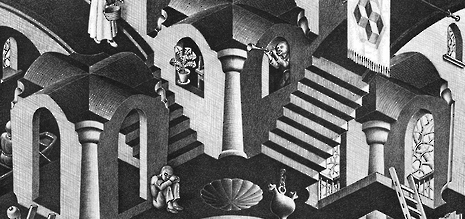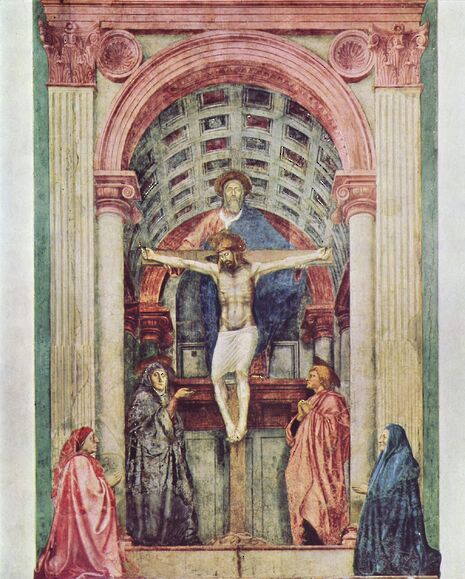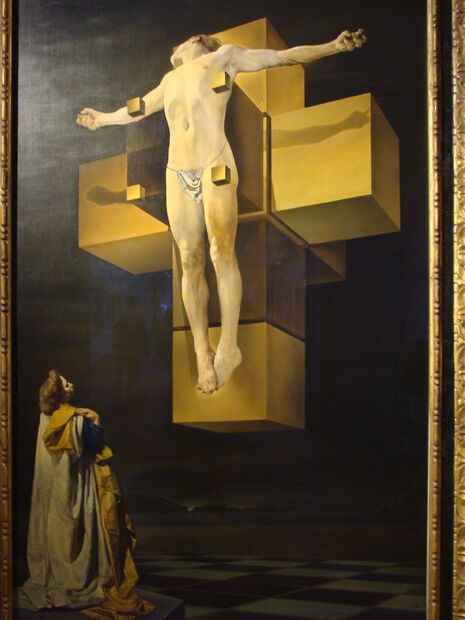Different subjects: a fresh perspective
In the first part of a series on how our academic studies inform a love of art, Joseph Krol discusses the evolution of mathematical perspective in art, from Masaccio to Dalí

It is an overworn cliché to point out that mathematics permeates so much of our lives. I write, however, with total sincerity in saying that the history of art is, in many ways, the history of applied mathematics. Studying one can enhance appreciation of the other, both on a technical and an emotional level. For instance, much of the intellectual development of the early Renaissance was, in both senses, the search for a new perspective, through the spirit of technical innovation. Mathematics would inspire art, and with time, art would come to inspire mathematics.
Earlier works from almost all artistic traditions, save the occasional attempt at foreshortening, are fundamentally flat affairs. The reaction against this stark representation of two-dimensional figures is an underlying theme of the works of the early masters. Though the introduction of the practical technique of perspective is generally credited to Italian architect, Brunelleschi, and soon transferred to major works by his friend Masaccio, the ideas were mathematically formalised in the book De pictura by Leon Battista Alberti.
Alberti makes a number of assumptions, including treating the eye as a point, and from there begins deducing the methods of accurately projecting distances. To me, this use of simplified principles is fundamentally mathematical – while not at all rigorous by modern standards, there is a clear attempt to derive and explain his methods, rather than simply stating them. Perusing the annals of art, one can see the book as a starting block in the race away from the constraints of the plane, whence the baton was handed to Uccello, Mantegna, Donatello, and eventually onto the likes of Escher and Dalí.

A key example of these methods is Masaccio’s great fresco of the Holy Trinity on the nave wall of the church of Santa Maria Novella at Florence. Prior to his untimely death at the age of 26, he displayed such virtuosity as to rank him in the highest tier of artists. His Trinity is a truly exemplary work: it displays the traditional scene of the crucifixion, though, strikingly, it seems to recede into the wall.
For one of the first times in art history, the depiction is truly believable, with the anguished Christ, the unrelenting Lord, and the strangely indifferent Mary all accurately foreshortened and rather lifelike. This use of perspective which underpins the painting functions through the technique of the ‘vanishing point’ – a pin-prick on the horizon towards which all lines recede. Though the painting slightly predates Alberti’s treatise, it still shows a mastery of the nascent techniques that Brunelleschi had recently developed.
“Anyone who has worked in four dimensions will no doubt agree that attempts to visualise these higher planes of reality present a strange, for some almost spiritual, experience.”
These techniques – almost a struggle towards an axiomatic beauty – resonate with me as they have with countless mathematicians from the Renaissance down. To give but one example, the French architect Girard Désargues was apparently so inspired by this artistic methodology as to develop the field of projective geometry, an extension of perspective. Through Felix Klein’s Erlangen programme, it would eventually inspire debate about the very foundations of mathematics itself.

As with mathematics, art progressed unabated over the centuries. In the 20th century, Escher worked with the great Cambridge geometer Coxeter, just as Masaccio had worked with Brunelleschi. Similarly, artists like Dalí would begin to introduce the exciting ideas of modern mathematics and physics in their works. One fascinating example is his 1954 work Crucifixion (Corpus Hypercubus), which depicts a strangely ethereal crucifix floating in a murky sky.
A little knowledge of mathematics reveals something deeper. The collection of cubes is not just cross-shaped – it forms a representation of the net of a ‘tesseract’, the cube’s four-dimensional analogue. In what I dearly hope is a nod to Masaccio half a millennium before, Dalí is again using the scene of the crucifixion to challenge the dimension of painting. But while Masaccio was striving to escape from the second dimension to the third, Dalí is pushing forward into the fourth. He does not quite get there – what we see is merely the three-dimensional net – but his intentions are clear.
In this arrested development there is, I believe, yet further significance. His apparent failure is perhaps a symbolic success. It is worth noting that the painting lies in the long shadow of Minkowski and Einstein’s ideas on spacetime, in which time takes on this role of an extra dimension. Anyone who has worked in four dimensions will no doubt agree that attempts to visualise these higher planes of reality present a strange, for some almost spiritual, experience, and few claim to succeed. This potent symbol – a reminder that so much is quite beyond the wit of man – holds a quite different message to that of Masaccio’s cross. A society which created the Trinity can only have believed in mankind; a society which created the Corpus Hypercubus can only have doubted it.
The interconnections between mathematics and art are dense, yet infinitely varied, and often quite beautiful. It is, of course, hardly essential to understand the geometry in order to enjoy art, just as one need hardly be a connoisseur of art to understand geometry. In some way, however, understanding the power of its application can make the study of the underlying mathematics somehow richer. Likewise, there is a certain joy in comprehending where an artist’s genius lies, and of being able to appreciate art on a deeper level. A knowledge of mathematics allows us not just to admire beauty, but to begin to understand it
 News / SU reluctantly registers controversial women’s soc18 December 2025
News / SU reluctantly registers controversial women’s soc18 December 2025 News / CUP announces funding scheme for under-represented academics19 December 2025
News / CUP announces funding scheme for under-represented academics19 December 2025 Features / Should I stay or should I go? Cambridge students and alumni reflect on how their memories stay with them15 December 2025
Features / Should I stay or should I go? Cambridge students and alumni reflect on how their memories stay with them15 December 2025 News / Cambridge welcomes UK rejoining the Erasmus scheme20 December 2025
News / Cambridge welcomes UK rejoining the Erasmus scheme20 December 2025 Science / ‘Women just get it more’: autoimmunity and the gender bias in research19 December 2025
Science / ‘Women just get it more’: autoimmunity and the gender bias in research19 December 2025









